The Importance of Outdoor Bird Cages for Avian Health
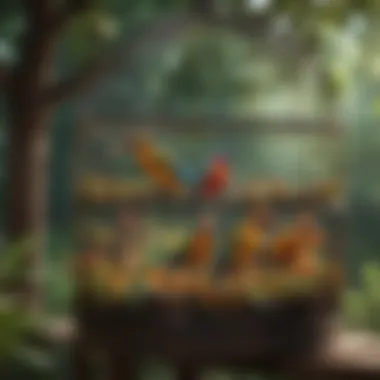
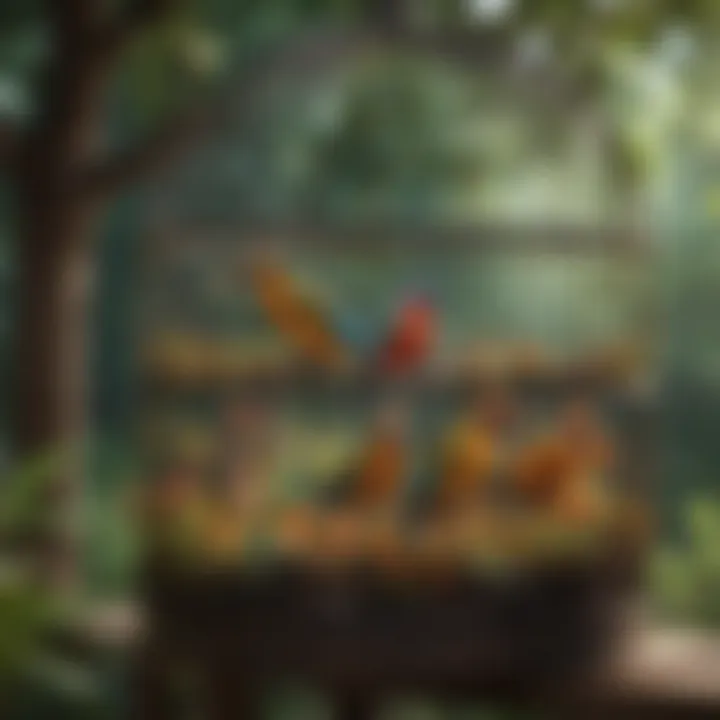
Intro
Pet birds can make wonderful companions. However, their physical and mental well-being highly depends on the environment they live in. Outdoor bird cages not only provide a change of scenery but can also enhance the enivronment by introducing self-awareness and social interaction natural for many bird species. This section will discuss the importance of outdoor bird cages, detailing the benefits they offer, such as exposure to natural sunlight, fresh air, and various environmental stimuli. We will also delve into the practical considerations that every bird owner should make when choosing an outdoor cage, ensuring the overall health and happiness of their avian friends.
Care Tips
Effective care for pet birds housed outdoors involves a structured approach to their daily needs and environment. This section covers daily routines, cage maintenance, hygiene practices, and seasonal care adjustments to enhance the living conditions for birds.
Daily Care Routines
Daily routines should include checking food and water levels, ensuring cleanliness, and maintaining proper temperatures within the cage. Owners must become familiar with their pet birds' unique feeding, bathroom, and social habits to develop an engaging routine.
Cage Setup and Maintenance
Setting up an outdoor cage requires attention to location and overall design to maximize comfort. Shielding the cage from harsh weather elements is crucial for keeping birds safe. Here are a few things to consider:
- Placement: Locate the cage where it receives appropriate sunlight and shade, away from direct draft.
- Dimensions: Choose cages that offer enough space for your birds to freely move.
- Material: Opt for non-toxic, weather-resistant materials that endure outdoor conditions.
Hygiene and Cleaning Practices
Maintaining a clean and hygienic enclosure minimizes the risk of diseases. Regular cleansing should involve:
- Daily removal of seepage and droppings.
- Weekly deep cleaning of the cage with bird-safe cleaning solutions.
- Planning to replace or wash any bedding materials regularly.
Seasonal Care Adjustments
Changes in seasons can greatly impact the living environment of outdoor housed birds. In summer, ensure access to shade and enough water to prevent overheating. During winter, renovations may include insulating materials around the cage.
Behavioral Insights
Observing your bird’s body language can provide many insights into their mental health. Birds have specific ways of expressing emotions. Identifying common cues is helpful for responsible ownership.
Understanding Bird Body Language
Birds use various physical cues to communicate. Extending wings may indicate excitement, while fluffed feathers suggest discomfort. Become familiar with your bird's unique signs as they can indicate mood or stress levels.
Common Behavioral Issues and Solutions
Some behavior issues like feather plucking or excessive screeching may arise in some pet birds. Identifying the stressor is vital in order to apply appropriate adjustments in achieving their well-being. Solutions may involve consulting a bird specialist or creating a more enriching environment.
Positive Reinforcement Techniques
Utilizing positive such as treats and praise encourages good behavior. By rewarding appropriate actions, pet owners can effectively nurture positive behavior tthroughstrong bonds.
Social Interaction Needs
Adequate social interaction is key for a happy pet bird. Daily interaction might seem daunting, yet even short ventures outside their cage while supervised can provide invaluable socialization time.
Nutrition Guides
Proper nutrition is vital for birds' health. Maintaining a balanced diet ensures they receive essential nutritional components.
Essential Diet Components
Birds require a combination of seeds, pellets, eggs, fruits, and vegetables in their diet to remain healthy. It’s important to research what specific types correspond with your bird species'.
Safe and Toxic Foods
Familiarize yourself with what foods are harmful! Foods like avocados or chocolate should be avoided at all costs to ensure your birds' safety.
Supplements and Treats
Consider supplements for added nutrients, especially calcium and vitamins. They benefit bird health and ecosystem-wide social interaction.
Feeding Strategies for Different Species
Different species have different dietary needs. You must tailor feeding routines according to your bird’s species for optimal health.
Wellness and Health
Routine checkups and general health practices are important aspects of avian life. This section discusses how to recognize illness and preventative measures to take for lasting health.
Routine Health Checkups
Birds require routine health assessments, just as a pet dog or cat would. Look for avian veterinarians who specialized care is crucial.
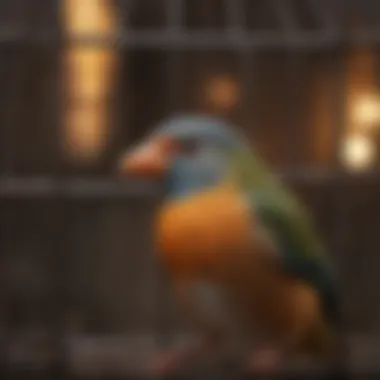
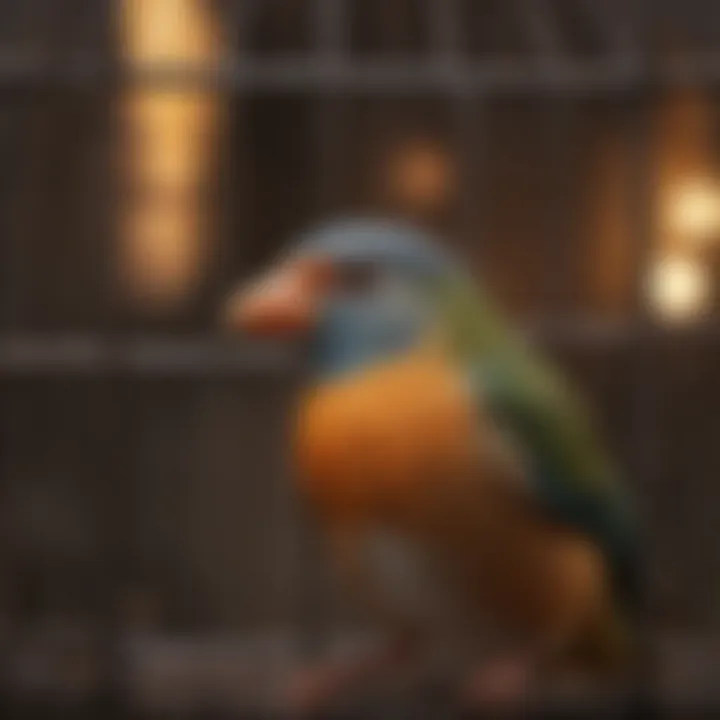
Identifying Symptoms of Illness
Watch for any unusual behavior or physical symptoms such as changes in eating habits or drooping wings. Training yourself to notice what's normal and what's not can save lives.
Preventative Care and Vaccinations
Discuss vaccination opportunities with your vet. Proper vaccinations minimize the chances of life-threatening disease exposure in pet birds.
Mental and Emotional Well-being
Be sure to provide your birds with stimulating environments that fulfill their emotional needs while keeping their minds active. Activities like exposing pet birds to novel though limited experiences keep them thriving indoors or outdoors.
Enriching Activities
Diverse activities promote avian wellness. Engage your bird in playing, training, exploring, and making items that help challenge their curiosity.
Toys and Playtime Ideas
Toys are vital in reducing boredom. Provide stimulating options for success. Birds enjoy seeing motion, particularly colorful items that mimic natural environmental cues.
Training and Tricks
Training your bird can improve your relationship and communication. Engaging them in household commands or tricks can provide a sense of achievent along side bonding time.
Outdoor Activities and Interaction
Plan supervised fly time if possible. Clear an appropriate space for tiny wings to embrace the outdoor air. Focus on being present with them to entrainment all sensory attributes of their aspirations.
DIY Projects for Mental Stimulation
Using materials around home for DIY projects presents instant challenges and engages different senses. Simple ideas might involve arranging perches or sources that provide gentle activities allow for healthy play.
A well-managed outdoor bird cage experience enhances the quality of life for dwarfed and captive avian friends by broadening a scope of overall happiness and improved nurture.
With consistent care, observation, and engagement, pet birds can become vibrant and of robust health while enjoying their outside environment.
Understanding Outdoor Bird Cages
Outdoor bird cages serve a crucial role in the lives of pet birds and their owners. Not only do they provide a designated space for birds to reside, but they also positively impact the well-being, behavior, and socialization aspects of avian life. The provision of appropriate outdoor housing fosters an environment where birds can exhibit natural behaviors, which is essential for their overall health. With the correct understanding, bird owners can enhance their pets' quality of life significantly.
\ > "Outdoor bird cages provide more than just a living space; they create an environment that mimics natural habitats, beneficial for behavioral development."
Integrating outdoor cages into bird care practices requires careful examination of various elements, including safety, size, and environmental suitability. Many bird owners may not realize that properly designed outdoor enclosures can lead to enriched experiences for their birds. Enhancing the understanding of amphibians includes knowledge about accessibility to sunlight, space for flight, and the importance of engaging stimuli such as natural features and toys.
The comprehension of salient attributes surrounding outdoor bird cages ultimately affects the decisions caregivers make. Choosing a suitable cage does considerably impact a bird’s quality and lifespan. It is imperative, thus, to delve deeper into specific purposes of outdoor enclosures to appreciate their necessity thoroughly.
The Purpose of Outdoor Enclosures
One prominent purpose of outdoor enclosures is to provide an expansive area for birds to explore. Unlike traditional indoor housing, outdoor cages allow for natural movement, encouraging physical activity vital for birds' health. Birds thrive in environments that stimulate their instinctual drive to perch, play, and interact with their surroundings. Moreover, exposure to elements such as wind and the sounds of nature can significantly elevate their daily experiences. The opportunity to engage with environments beyond one's standard surroundings can drastically alter social habits and adaptability.
Another purpose centers around the concept of safeguarding birds while providing them freedom. Outdoor cages are designed to prioritize security, ensuring birds are defended against potential hazards while enjoying open spaces. Access to an open-air enclosure not only elevates happiness levels but empowers birds to express their unique personalities. Finding harmony between safety and freedom encapsulates one of the broader roles of outdoor enclosures in avian lifestyles.
Comparative Benefits of Indoor and Outdoor Housing
Assessing the comparative benefits between indoor and outdoor housing unveils key insights relevant to pet bird owners. Indoor housing has advantages, particularly in terms of controlled climates and secure settings. However, these settings may lack various stimuli that outdoor cages inherently provide.
- Outdoor cages often reduce stress levels. The fresh air and natural scents from plants aid in alleviating anxiety, offering a relatively peaceful habitat.
- Indoor units, while safe, usually confine birds to minimal space, leading to lethargy or behavioral issues.
- Frequency of exposure to sunlight within outdoor housing promotes natural habits such as vitamin D synthesis, essential for healthy bone development.
Furthermore, the potential for developing social interactions is markedly enhanced when birds are able to hear other birds or animals outside. Such environmental exposure creates enriching dynamics that cannot be easily replicated indoors.
In summary, understanding outdoor bird cages reveals their multifaceted benefits to avian life. The ensuing sections will further expand upon aspects integral to choosing appropriate outdoor cages, beginning with detailed assessments of what goes into selecting the right materials, size, and design features.
Choosing the Right Outdoor Cage
Selecting the appropriate outdoor cage for your birds is a significant point of consideration for every bird owner. The right cage does not only provide a safe setting but also contributes to the overall happiness and health of the avian inhabitants. Different bird species require unique environments that accommodate their behavioral needs, ensuring they experience a naturalistic and enriching daily existence.
Material Considerations for Durability
When it comes to outdoor bird cages, durability must be paramount in your selection. Different materials offer varied levels of strength and resistance against the elements. For high-quality outcomes, stronger materials like stainless steel or powder-coated aluminum offer greater protection against rust or deterioration.
- Stainless Steel: Known for its longevity and resistance to corroding, stainless steel is an excellent choice for outdoor cages. It doesn't require frequent replacements.
- Aluminum: Lightweight yet sturdy, polished aluminum also poses impressive durability features against weather, ensuring a stronger cage.
- Welded Wire: This type of construction not only denotes strength but also promotes safety by minimizing spaces where birds might escape. Look for coatings that keep the wire taut and avoid rust.
- Wood: Natural wood can blend well into the outdoor scenery but should be treated specially to withstand moisture and weather conditions. Always ensure non-toxic treatments are used.
Collectively, choosing high-quality materials guarantees that outdoor cages maintain their integrity and functionality over time.
Size Requirements Based on Bird Species
The size of the cage is crucial, as it directly impacts the birds' movement and overall well-being. Each species has its own tolerance and needs, and understanding these figures promotes their mental and physical health.


- Small Birds (like Budgerigars or Finches) need at least a 24 x 18 x 18 inch cage, but more space is always beneficial for flight.
- Medium Birds (including Cockatiels and Lovebirds) are better off in cages measuring no less than 36 x 24 x 24 inches, allowing ample room for flapping and climbing.
- Large Birds (like Conures or Amazons) require spacious homes, at least 48 x 36 x 36 inches, if possible. Extra height is also advantageous for climbers.
Wider cages often provide more effective use of space, yielding areas for activities like playing, swinging, and exploring. Each configuration should be personalized according to the birds it accommodates, in order to thrive.
Design Features for Avian Comfort
Beyond just structure, the expected design features significantly influence avian comfort in outdoor cages. A well-planned enclosure engages and comforts the birds and promotes a healthier living space.
- Perches: It's essential to include variable perch sizes and materials. Using natural wood promotes simultaneous activity, as different birds utilize different perch configurations. Birds might taper their beaks for natural care on non-damaging perches.
- Ventilation: Opt for cages that guarantee adequate airflow, preventing heat buildup during extreme temperatures. Resulting fresh air enhances their liveability.
- Shelters: Add shaded areas for cover in case of sudden exposure to weather changes. Dedicated zones ties in comfort and survival requirement for these birds.
- Feeding Stations: Simple access to food and water that avoids sounds detrimental to health. Place feeder platforms at lower and higher points in the cage to allow easy access.
Maintaining these design elements furthers satisfaction, ensuring that a well-considered layout directly contributes to an ideal outdoor habitat.
”A thoughtfully designed aviary promotes a thriving environment for pet birds, enabling them to exhibit natural behaviors benefited by engaging surroundings.”
Environmental Factors Impacting Outdoor Cages
Outdoor bird cages serve multiple functions, and understanding the environmental factors that influence them is critical. Several key elements play an essential role in protecting the well-being of pet birds. These include weather conditions, effective sunlight and shade management, and strategies for predator protection. Awareness of these factors empowers bird owners to create a secure and comfortable outdoor space, ultimately helping to enhance the quality of life for their birds.
Weather Considerations
Weather can drastically impact the health and comfort of birds housed outside. Different species have differing tolerances to heat, cold, wind, and rain. For instance, tropical birds may find cold temperatures stressful, while others from temperate climates may not do well in excess heat. Bird owners must take into account seasonal shifts and prepare cages accordingly.
Key weather considerations include:
- Shade during hot days: Providing adequate shadow is essential in high temperatures. Birds can suffer from heat stress, which could be fatal.
- Shelter from rain and wind: Cages should be equipped to protect birds from elements.Key design features might include a waterproof covering.
- Temperature fluctuations: Routine monitoring of temperatures helps in making necessary adjustments.
Overall, proper weather arrangements encourage birds to utilize their outdoor space while remaining healthy.
Sunlight and Shade Management
Striking a balance between sunlight and shade is vital for outdoor enclosures. Birds benefit from natural sunlight, which is effective in helping to strengthen their immune systems but should be moderated. Shifting environmental industries mean that full sun exposure without breaks can lead to overheating and sunburns.
Some important points related to sunlight and shade management are:
- Arranging cages in partial sun: Positioning cages in places that receive morning sun while enjoying afternoon shade can offer optimal conditions.
- Using coverings and shelters: Lightweight tarps or plants can provide necessary shade without totally eliminating exposure to sunlight. This variant can help create a psychology comforting habitat.
- Rotating perches in the cage: Modify and sometimes use the angles for sunlight exposure, allowing birds to move and pick preffered light.
In short, bird owners should strategize sunlight access while benefiting from cooling areas which contribute to well-being.
Predator Protection Systems
Predator threats remain a significant concern for birds housed outdoors. Cats, hawks, and raccoons are just a few examples of potential aggressors. It is crucial to employ defensive structures and barriers to ensure the safety of the birds.
Several steps for effective predator protection systems include:
- Enclosed, strong fencing: Utilize materials such as stainless steel that can resist earthbound attacks.
- Visual revulsives: Today it’s beneficial to incorporate reflective materials.Critically, implementation counteracts predatory habits
- Secure locks and clasps: A quality latch on entryways, minimized direct access for alerts against potential breakout matches.
Having an effective predator protection system is imperative. Thus bird owners must prioritize safety considerations to prevail against threats that may arise.
Familiarizing with environmental factors greatly differs the quality of birds’ lives. Knowledge empowers quicker adjustments to care where mistreatment may elicit protection first hand which improves owner experience too.
Health Benefits of Outdoor Exposure for Birds
Outdoor exposure offers significant health benefits for birds. These advantages extend beyond mere enjoyment; they are essential for the wellbeing of avian life in domestication. Many owners realize that breathable fresh air and the sun’s rays contribute positively to their birds' overall health. Understanding these health benefits provides a foundation for why outdoor bird cages are crucial.
Naturalism and Behavioral Enrichment
Birds are inherently wild creatures. Their natural instincts drive them to engage in behaviors crucial for their mental and physical health. Outdoor cages mimic their native habitats and enhance behavioral productivity. Exposure to natural stimuli encourages various functions such as foraging, flying short distances, and even experiencing different temperatures throughout the day. This depth of engagement prevents lethargy and boredom, common issues faced in confined spaces.
Some key aspects encouraging this behavior include:
- Natural Interaction: Birds observe exterior activities like moving clouds or seeing other creatures, which stimulates their senses.
- Varied Enrichment: Outdoor environments allow for diverse interactions with toys and foraging opportunities that closely resemble their wild experiences.
- Social Dynamics: When posed within a familiar setting, pet birds can engage in observational behaviors toward nests or siblings, promoting natural social skills.
Thus, enhancing a bird's natural habitat through outdoor exposure increases health and provides enriching experiences.
Vitamin Synthesis and Its Importance
Vitamin D plays an essential role across species. For birds, sunlight leads to the synthesis of this vital nutrient, which promotes vital bodily functions. An adequate link exists between exposure to natural sunlight and improved bone density, calcium absorption, and metabolism functioning. Birds can bask in sunlight during warmer times, converting it to sustenance essential for their health. The direct implication here is prevention of deficiencies that can lead to lethargy or developmental issues.
Considerations to ensure sufficient Vitamin D synthesis include:
- Sunlight Access: Positioning outdoor cages towards areas where sunlight can directly hit.
- Shade Awareness: Provide shaded areas, protecting from overheating during high sunlight phases yet balancing access to direct sunlight.
- Routine Exposure: Incorporating regular outdoor opportunities into the bird's daily activities cultivates a habitual process of nutrient intake.
In summary, providing appropriate outdoor exposure for birds boosts both natural behaviors and essential health advantages. These elements are what bring the essence of keeping a healthy bird just that.
Proper care through emphasis on naturalism promotes diverse interactions leading to profound health benefits.
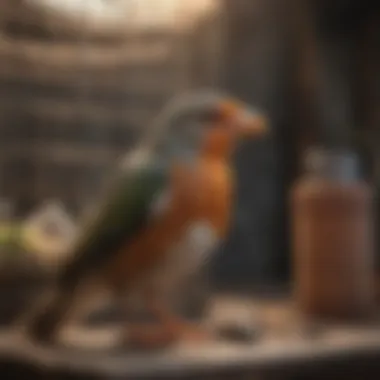
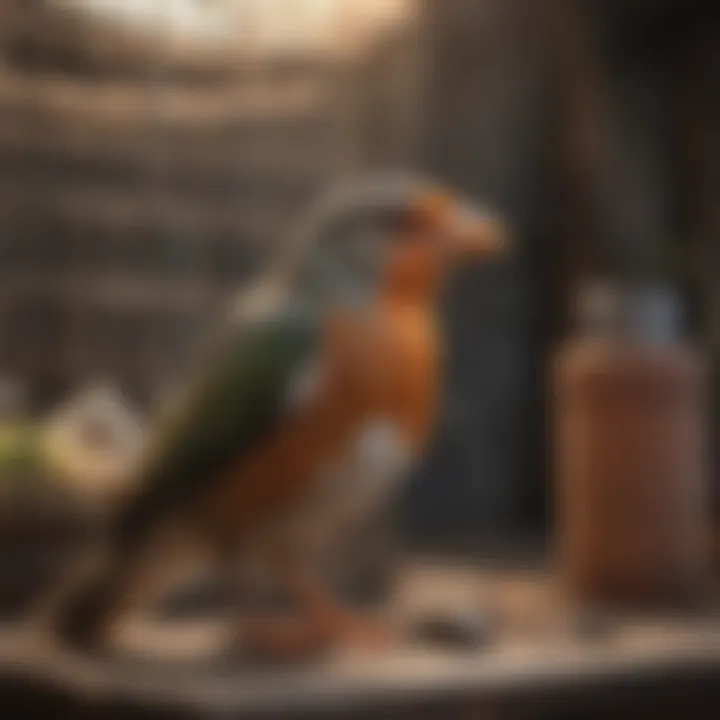
Enriching Your Outdoor Bird's Experience
Enriching your outdoor bird's experience is fundamental to ensuring their happiness and health. Birds are intelligent and inquisitive creatures that thrive on stimulation. An environment that offers enrichment benefits them both mentally and physically. This section focuses on practical elements including toys, accessories, plant life, and natural perches that add value to their outdoor living space.
Interactive Toys and Accessories
Interactive toys and accessories are vital for keeping your bird engaged and entertained. They stimulate their natural instincts like foraging, climbing, and playing. Different types of toys include swings, chew toys, and puzzle feeders. Each of these engages a bird in distinct ways, preventing them from feeling dull or stagnant in their environment.
Regularly rotating toys can also maintain interest. Just as people need variety, birds enjoy new challenges. Carved wooden toys or sisal ropes introduce textures for them to explore. Foraging toys specially designed to release treats promote behaviors vital to their well-being. It is crucial to choose materials that are safe, as birds are prone to chewing on anything they find. Thus, avoid toxic materials such as certain plastics or treated wood.
Benefits of interactive toys:
- Reduces boredom
- Encourages natural behaviors
- Strengthens physical health through play
Plant Life and Natural Perches
Integrating plant life and natural perches into the outdoor cage creates a garden-like atmosphere. Birds are naturally attracted to greenery, which enhances their wellbeing. Leaving appropriate foliage can also simulate a natural habitat, giving them an instinctual sense of security.
Choosing safe plants is critical. Safe options commonly included are spider plants, Boston ferns, and various herbs like basil or cilantro. Avoid any flora that is toxic to birds. Research is recommended or consult with a veterinarian to understand potential risks.
Natural perches should also reflect the birds' native surroundings. Using branches from untreated trees, such as manzanita or willows, helps maintain their claws and provides a sense of comfort. Varying the diameter and texture of the perches supports foot health, reducing risks of conditions like torticollis. These considerations turn a simple cage into a thriving habitat that directly contributes to the species well-being.
"A well-enriched environment is essential. Without proper engagement, birds can develop psychological issues stemming from stress and boredom."
Creating a positive outdoor experience is a step further in enhancing their avian life. Regardless if you own budgies, cockatiels, or even more exotic species, these adjustments matter significantly. The focus should always be on creating diverse yet safe options that match their natural behaviors.
Maintenance of Outdoor Bird Cages
Proper maintenance of outdoor bird cages is crucial to ensure the health and well-being of pet birds. It is not merely a routine chore, but rather a fundamental aspect of bird care that involves monitoring hygiene and structural integrity. Neglecting this can lead to disease, stress in birds, and, ultimately, detract from their quality of life. Therefore, enthusiasts must integrate maintenance practices into their regular bird-care regimen.
Cleaning Protocols for Hygiene
Maintaining cleanliness inside outdoor bird cages can significantly reduce the risk of infections and harmful bacteria that could impact birds. Pens need to be cleaned at least once a week or more frequently if birds are particularly messy. Key components of the cleaning protocol include:
- Remove Food and Water Containers: Start by taking out all feeding and watering containers. This helps prevent contamination.
- Dispose of Waste: Any leftover food and droppings should be swept or scraped away. Droppings can harbor germs that may affect avian health.
- Cleaning Solutions: It is recommended to use gentle, bird-safe cleansers. Solutions that successfully eliminate bacteria without leaving harmful residues, such as a mild soap solution followed by a rinse with warm water, are preferable.
- Dry Thoroughly: After rinsing, ensure that all surfaces are dried completely to discourage mold growth.
Creating a cleansing schedule to keep track of maintenance routines is beneficial. This can be as simple as marking a cover in a calendar application or notebook to always stay on top of needed cleanings.
Inspection for Wear and Damage
Regular inspections for wear and damage are integral to maintaining safety and comfort for birds housed in outdoor cages. Anomalies can lead to injury or escape. Inspections should be conducted monthly, with the following points in mind:
- Check for Rust or Corrosion: Metal enclosures are susceptible to rust, which can compromise structural integrity. Inspect all parts for visible signs of rust or corrosion.
- Inspect Fencing: Ensure that there are no loose wires, sharp edges, or holes that could allow predators entry or birds to escape.
- Examine the Foundation: Cages can sag or shift due to rain or ground erosion. Make sure the cage is level and stable.
- Evaluate Wear on Perches and Accessories: Wood can splinter, while plastic parts may become brittle under sun exposure. Be sure to replace items as needed to maintain safety and comfort.
Regular maintenance will help you avoid larger problems in the future, providing a safe and healthy environment for your birds.
Together, both cleaning and inspection ensure that outdoor bird cages remain a beneficial aspect of avian life rather than a source of risk.
Legal Considerations for Outdoor Bird Housing
Understanding the legal parameters surrounding outdoor bird housing is critical for pet bird owners. Many aspects should be taken into account, such as local regulations and the legal implications tied to keeping specific bird species outdoors. Being informed ensures both the safety of birds and adherence to the law.
Local Regulations on Bird Cages
Local governments often impose regulations on bird cages to guarantee adequate living conditions for avian pets. These regulations can differ significantly depending on the region, municipality, or even neighborhood. Some key points to consider include:
- Size Requirements: There are usually minimum size regulations for cages to guarantee adequate space for the birds. Cobbling together spaces without considering dimensions can lead to enforcement actions.
- Material Specifications: Importantly, your pet bird's cage might need to reflect certain materials. Authorities might specify materials that are non-toxic and suitable for bird storage. Using inappropriate supplies could lead to penalties.
- Aesthetic Restrictions: Some local laws may mandate that cages meet specific aesthetic requirements to harmonize with community standards. For example, visible cage designs or colors might need committee low-key approval.
By being aware of these regulations, bird owners add peace of mind to their arrangements, assured that they are complying fully with local instructions.
Permits Required for Specific Species
Certain bird species may require specific permits for their owners to legally house them outdoors. These regulations often happen because some birds are endangered or protected under animal rights laws. Here are einige aspects to consider:
- Endangered Species: Birds that are close to extinction often come with strict housing laws, including the necessity for permits. This aims to safeguard their already precarious survival.
- Intrusive Species: Some species are regulated because they can escalate negative impacts on local ecosystems. Owning such birds outdoors may thus require specific permits to ensure legal compliance.
- Documentation Needs: In some instances, minimal documentation, like proof of avian health or natural habitat conditions, might also be price-worthy to apply for certain permits. Failing in these areas might lead to fines.
The responsibility to understand and monitor such legal obligations is crucial. Ignorance often leads to penalties or makes it challenging to enjoy keeping birds outdoors. This segment touches upon necessary considerations, but diligent research and compliance prove essential in treating birds ethically.
Culmination
Summarizing the Value of Outdoor Bird Cages
Outdoor bird cages serve multiple purposes and their value is profound. First, these cages broaden the living space for birds, which reduces stress and promotes exploration. An avian safari not found inside houses supports their curious nature as they interact with a variety of stimuli. Key aspects include:
- Healthier Lifestyles: Being outside exposes birds to fresh air and sunlight, crucial for vitamin D production.
- Behavioral Enrichment: This environment allows birds to exhibit natural behavior patterns. They can fly, jump, and explore, enhancing their engagement.
- Safety Considerations: While positioning the cage outdoors, focusing on proper materials and predator protection is vital. All owners must ensure the safety and comfort of their birds, integrating protective features into the cage design.
Utilizing outdoor bird cages doesn’t only offer recreational opportunities. It cultivates healthy habits and boosts longevity.
Outdoor cages must cater specifically to the bird species. For instance, larger birds need bigger enclosures for ample space to move. On the other hand, small birds may be comfortable in a more compact area yet also benefit from a natural setting.
The value of outdoor cages extends beyond mere design; the experiences they offer redefine bird keeping. Enrichment, safety, and appropriate sizing come together to build an effective outdoor living arrangement that not only meets the desires of bird owners but, most importantly, enhances the quality of life for the birds themselves.
For more information on creating a safe and enriching environment for pet birds, you may explore the discussions on Reddit or the knowledge found on Wikipedia.















